The global medical smart drug cabinet market is projected to reach USD 6,978.7 million by 2035, recording an absolute increase of USD 3,529.0 million over the forecast period. The market is valued at USD 3,449.7 million in 2025 and is set to rise at a CAGR of 7.3% during the assessment period. The overall market size is expected to grow by approximately 2.0 times during the same period, supported by increasing healthcare digitization, growing demand for medication safety systems, and expanding adoption of automated pharmacy solutions worldwide. However, high implementation costs and complex integration requirements with existing hospital systems may pose challenges to market expansion.
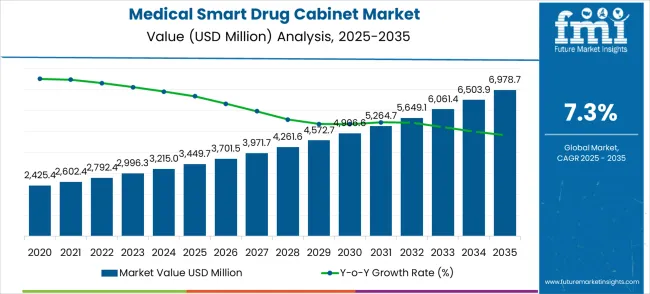
Between 2025 and 2030, the medical smart drug cabinet market is projected to expand from USD 3,449.7 million to USD 4,906.6 million, resulting in a value increase of USD 1,456.9 million, which represents 41.3% of the total forecast growth for the decade. This phase of development will be shaped by rising demand for medication management solutions, product innovation in automated dispensing technologies and security systems, as well as expanding integration with electronic health record platforms and hospital information systems. Companies are establishing competitive positions through investment in artificial intelligence capabilities, patient safety enhancement solutions, and strategic market expansion across hospitals, clinics, and long-term care facilities.
From 2030 to 2035, the market is forecast to grow from USD 4,906.6 million to USD 6,978.7 million, adding another USD 2,072.1 million, which constitutes 58.7% of the overall ten-year expansion. This period is expected to be characterized by the expansion of specialized cabinet systems, including temperature-controlled storage solutions and integrated monitoring platforms tailored for specific medication categories, strategic collaborations between technology providers and healthcare facility operators, and an enhanced focus on regulatory compliance and patient safety optimization.
| Metric | Value |
|---|---|
| Market Value (2025) | USD 3,449.7 million |
| Market Forecast Value (2035) | USD 6,978.7 million |
| Forecast CAGR (2025-2035) | 7.3% |
The medical smart drug cabinet market grows by enabling healthcare facilities to ensure secure medication storage and enhanced patient safety through automated dispensing systems. Healthcare administrators face mounting pressure to reduce medication errors and improve operational efficiency, with smart cabinet systems typically reducing medication dispensing errors by 60-80% compared to traditional manual methods, making smart drug cabinets essential for modern healthcare infrastructure. The healthcare industry's need for regulatory compliance and patient safety creates demand for advanced cabinet solutions that can handle controlled substance management, provide audit trails, and ensure seamless medication tracking without service interruptions.
Healthcare digitization initiatives and electronic health record integration drive adoption in hospital pharmacies, nursing units, and outpatient facilities, where reliable medication management systems have a direct impact on patient care quality and operational efficiency. Government regulations promoting medication safety and healthcare quality improvement drive adoption across acute care, long-term care, and specialty healthcare applications. However, budget constraints for healthcare technology upgrades and the complexity of integrating smart cabinet systems with existing hospital workflows may limit adoption rates among smaller healthcare facilities and developing regions with limited capital resources.
The market is segmented by Cabinet Type, Application, and region. By Cabinet Type, the market is divided into Smart Dispensing Cabinet, Smart Storage Cabinet, Smart Refrigerated Cabinet, Mobile Medication Management Cart, and Others. Based on the Application, the market is categorized into Hospital Pharmacy Management, Clinical Department Drug Distribution, Cold Chain Drug Storage, Emergency Drug Management, and Others. Regionally, the market is divided into Asia Pacific, Europe, North America, Latin America, and Middle East & Africa.
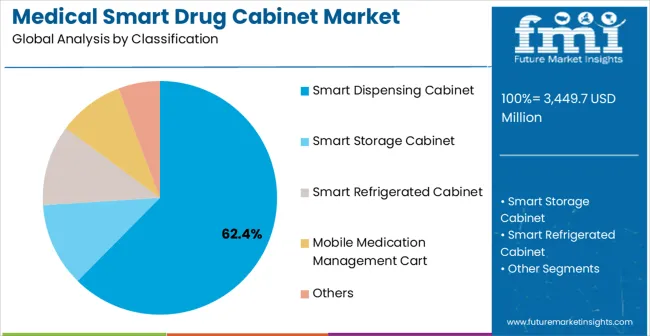
Smart dispensing cabinet is projected to account for 62.4% share of the Medical Smart Drug Cabinet Market in 2025. This dominant position is supported by the technology's widespread application in hospital pharmacy management, nursing units, and medication distribution centers, where automated dispensing capabilities provide secure and efficient medication management solutions. The segment enables stakeholders to benefit from standardized dispensing procedures, reduced medication errors, and enhanced security features that comply with international healthcare safety standards and controlled substance regulations.
The widespread adoption of smart dispensing systems in healthcare facilities across major medical centers worldwide drives consistent demand for these solutions, as healthcare operators prioritize proven technologies that minimize patient safety risks while providing reliable performance and comprehensive audit capabilities.
Smart Storage Cabinet systems represent 22.8% of the market share, primarily serving specialized medication storage requirements and inventory management applications that require secure storage without automated dispensing capabilities. These systems are essential for medication storage in clinical departments, specialty units, and facilities where controlled access and inventory tracking are priorities. Smart Refrigerated Cabinet solutions account for 8.7% market share, serving temperature-sensitive medication storage requirements including vaccines, biologics, and specialized pharmaceuticals that require precise climate control.
Mobile Medication Management Cart systems represent 4.3% of the market share, primarily serving bedside medication administration and mobile healthcare applications where portability and point-of-care access are essential. The Others category, accounting for 1.8% market share, includes specialized cabinet solutions designed for specific applications such as emergency medication storage and experimental healthcare technologies.
Key advantages include:
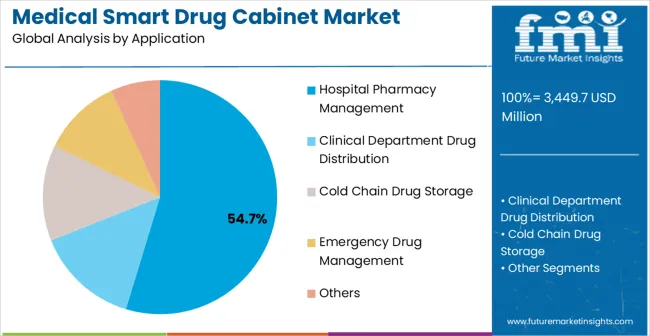
Hospital pharmacy management applications are expected to represent 54.7% share of medical smart drug cabinet applications in 2025. This leading position reflects the critical role of smart cabinet systems in central pharmacy operations, medication distribution networks, and pharmaceutical inventory management, where secure storage and automated dispensing are essential for patient safety and regulatory compliance. The segment provides critical support for medication management in high-volume healthcare operations where consistent pharmaceutical performance directly impacts patient outcomes and healthcare quality metrics.
Growth drivers include healthcare digitization trends, increasing demand for medication safety solutions, healthcare facility investments in automated pharmacy infrastructure, and the need for regulatory compliance systems that support quality assurance and patient safety goals.
Clinical department drug distribution applications account for 24.6% of the market share, serving nursing units, intensive care units, and specialized clinical departments that require secure medication storage and controlled access capabilities. Cold Chain Drug Storage applications represent 11.3% market share, primarily focused on vaccine storage, biologic medication management, and temperature-sensitive pharmaceutical storage that requires precise environmental controls and monitoring systems.
Emergency Drug Management applications contribute 6.8% market share, supporting emergency departments, crash cart management, and critical care facilities where rapid medication access and inventory management are essential for patient care. The Others category, representing 2.6% market share, includes specialized applications such as outpatient clinic medication management and long-term care facility pharmaceutical storage.
Key market dynamics include:
The market is driven by three concrete demand factors tied to healthcare digitization outcomes. First, medication safety requirements create increasing demand for automated dispensing systems, with healthcare facilities reporting 60-80% reduction in medication errors through smart cabinet implementation, requiring comprehensive smart drug cabinet infrastructure. Second, regulatory compliance mandates and healthcare quality improvement initiatives drive mandatory adoption of secure medication storage systems, with many healthcare systems setting targets for 90-95% automation of medication management by 2030.
Third, technological advancements in artificial intelligence and machine learning enable more efficient and reliable cabinet solutions that reduce operational costs while improving patient safety standards and inventory management capabilities. The growing emphasis on healthcare digitization creates additional demand for intelligent cabinet systems that integrate with electronic health records and provide real-time monitoring capabilities for medication usage and inventory optimization.
Market restraints include high capital investment requirements that can deter smaller healthcare facilities from upgrading their medication management infrastructure, particularly in developing regions where funding for healthcare technology modernization remains limited. Technical complexity poses another significant challenge, as implementing advanced cabinet systems requires specialized training programs and workflow integration, potentially causing delays in deployment and increased implementation costs.
Regulatory compliance requirements across different healthcare systems create additional complexity for manufacturers and healthcare operators, demanding ongoing adaptation to varying safety standards and certification processes. The complexity of integrating smart cabinet systems with existing hospital information systems presents workflow challenges that may result in extended implementation timelines and higher integration costs than initially projected.
Key trends indicate accelerated adoption in Asia-Pacific markets, particularly China and India, where rapid healthcare infrastructure development and medical facility expansion drive comprehensive medication management system deployment. Design shifts toward artificial intelligence-enabled cabinet solutions with predictive analytics, automated inventory management, and integrated patient identification systems enable proactive medication management approaches that reduce waste and operational costs.
The increasing focus on cold chain management and specialized storage capabilities drives demand for advanced cabinet solutions that can handle temperature-sensitive medications and provide comprehensive environmental monitoring across healthcare networks. However, the market thesis could face disruption if alternative medication management technologies or significant changes in healthcare automation standards minimize reliance on traditional smart drug cabinet systems.
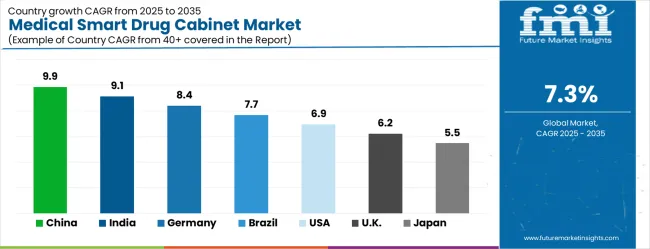
| Country | CAGR (2025-2035) |
|---|---|
| China | 9.9% |
| India | 9.1% |
| Germany | 8.4% |
| Brazil | 7.7% |
| USA | 6.9% |
| UK | 6.2% |
| Japan | 5.5% |
The medical smart drug cabinet market is accelerating worldwide, with China leading at a CAGR of 9.9%, driven by massive healthcare infrastructure expansion and government-backed healthcare digitization investments. Close behind, India, growing at 9.1% CAGR, is propelled by hospital modernization and smart healthcare initiatives, positioning it as a strategic Asia-Pacific hub. Germany advances steadily with an 8.4% CAGR, supported by integration of advanced healthcare technologies within Europe's medical infrastructure.
Brazil, expanding at 7.7% CAGR, emphasizes healthcare modernization and patient safety improvement. The USA records 6.9% CAGR, reflecting strong adoption of advanced healthcare technologies, while the UK (6.2% CAGR) and Japan (5.5% CAGR) sustain consistent healthcare technology modernization. Together, China and India anchor global growth momentum, while others contribute stability and regional diversity.
The report covers an in-depth analysis of 40+ countries; seven top-performing countries are highlighted below.
China demonstrates the strongest growth potential in the medical smart drug cabinet market with a CAGR of 9.9% through 2035. The country's leadership position stems from massive healthcare infrastructure expansion projects, government-backed healthcare digitization programs, and stringent medication safety regulations driving the adoption of automated medication management systems.
Growth is concentrated in major metropolitan areas, including Beijing, Shanghai, Guangzhou, and Shenzhen, where hospitals and healthcare facilities are implementing advanced cabinet solutions for enhanced operational efficiency and patient safety. Distribution channels through state-approved medical equipment suppliers and government procurement programs expand deployment across public hospitals and private healthcare facilities.
The country's "Healthy China 2030" strategy provides policy support for smart healthcare initiatives, including advanced medication management system adoption.
Key market factors:
In Delhi, Mumbai, Bangalore, and Chennai, adoption of medical smart drug cabinet systems is accelerating across hospital networks and healthcare facilities, driven by rapid healthcare infrastructure development and government digital health initiatives. The market demonstrates strong growth momentum with a CAGR of 9.1% through 2035, linked to comprehensive healthcare modernization and increasing focus on patient safety solutions.
Indian healthcare authorities are implementing advanced cabinet systems and monitoring platforms to enhance operational efficiency while meeting growing patient demand in expanding metropolitan healthcare networks. The country's National Digital Health Mission creates sustained demand for automated medication management solutions, while increasing emphasis on healthcare quality improvement drives adoption of smart cabinet systems.
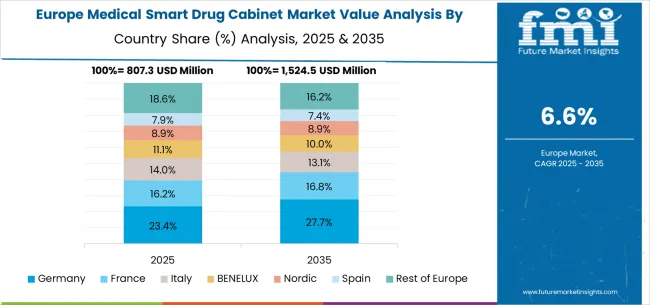
Germany's advanced healthcare sector demonstrates sophisticated implementation of medical smart drug cabinet systems, with documented case studies showing significant medication error reduction and operational efficiency improvements through intelligent medication management platforms. The country's healthcare infrastructure in major cities, including Berlin, Munich, Hamburg, and Frankfurt, showcases integration of advanced cabinet technologies with existing hospital information systems, leveraging expertise in medical technology and automation systems.
German healthcare operators emphasize precision engineering and reliability standards, creating demand for high-performance cabinet solutions that support continuous improvement initiatives and patient safety requirements. The market maintains steady growth through focus on Industry 4.0 integration and regulatory compliance, with a CAGR of 8.4% through 2035.
Key development areas:
Brazil's market expansion is driven by diverse healthcare infrastructure demand, including hospital systems in São Paulo and Rio de Janeiro, healthcare facilities in Brasília and other major cities, and comprehensive healthcare modernization across multiple states. The country demonstrates promising growth potential with a CAGR of 7.7% through 2035, supported by federal government healthcare investment programs and state-level medical facility development initiatives.
Brazilian healthcare authorities face implementation challenges related to capital investment constraints and technical expertise availability, requiring phased deployment approaches and financing support from international development institutions. However, growing healthcare quality regulations and patient safety demands create compelling business cases for cabinet adoption, particularly in metropolitan areas where healthcare efficiency has a direct impact on patient outcomes.
Market characteristics:
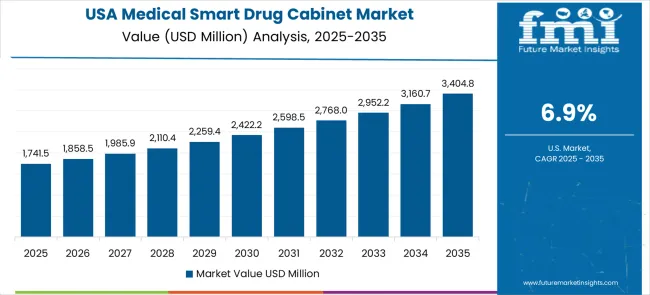
The USA market leads in advanced cabinet system innovation based on integration with electronic health records and artificial intelligence technologies for enhanced medication management efficiency. The country shows strong potential with a CAGR of 6.9% through 2035, driven by the modernization of existing healthcare infrastructure and the expansion of hospital networks in major metropolitan areas.
American healthcare facilities are adopting intelligent cabinet systems for operational efficiency improvement and regulatory compliance, particularly in regions with strict medication safety standards and aging healthcare infrastructure requiring comprehensive upgrades. Technology deployment channels through established healthcare technology distributors and direct manufacturer relationships expand coverage across hospital systems and healthcare facility operators.
Leading market segments:
In London, Manchester, Birmingham, and Glasgow, healthcare systems are implementing medical smart drug cabinet solutions to modernize aging medication management infrastructure and improve operational efficiency, with documented case studies showing significant improvements in medication safety and inventory management. The market shows moderate growth potential with a CAGR of 6.2% through 2035, linked to the ongoing modernization of NHS facilities and private healthcare networks.
British healthcare operators are adopting intelligent cabinet and monitoring platforms to enhance system reliability while maintaining patient safety standards demanded by regulatory authorities and healthcare quality organizations. The country's established healthcare infrastructure creates sustained demand for replacement and upgrade solutions that integrate with existing hospital information systems.
Market development factors:
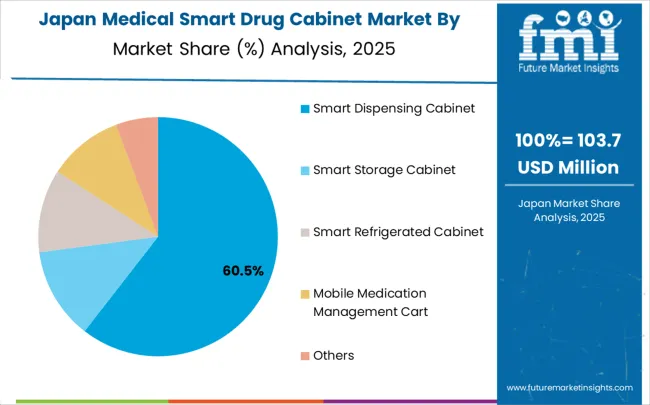
Japan's Medical Smart Drug Cabinet Market demonstrates sophisticated implementation focused on precision engineering and operational excellence optimization, with documented integration of advanced medication management systems achieving significant improvements in patient safety and medication administration efficiency across hospital and healthcare networks.
The country maintains steady growth momentum with a CAGR of 5.5% through 2035, driven by healthcare facilities' emphasis on reliability standards and continuous improvement methodologies that align with lean healthcare principles applied to medication management operations. Major metropolitan areas, including Tokyo, Osaka, Nagoya, and Fukuoka, showcase advanced deployment of intelligent cabinet platforms where medication management systems integrate seamlessly with existing electronic health records and comprehensive quality management programs.
Key market characteristics:
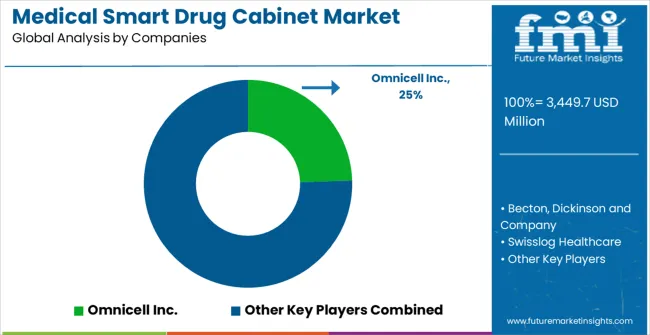
The Medical Smart Drug Cabinet Market features approximately 15-20 meaningful players with moderate concentration, where the top three companies control roughly 45-50% of global market share through established technology platforms and extensive healthcare industry relationships. Competition centers on technological innovation, service capabilities, and integration expertise rather than price competition alone.
Market leaders include Omnicell Inc., Becton, Dickinson and Company, and McKesson Corporation, which maintain competitive advantages through comprehensive medication management solution portfolios, global service networks, and deep expertise in the healthcare industry, creating high switching costs for customers. These companies leverage installed base relationships and ongoing maintenance contracts to defend market positions while expanding into adjacent healthcare technology applications.
Challengers encompass Swisslog Healthcare and Capsa Healthcare, which compete through specialized cabinet solutions and strong regional presence in key healthcare markets. Technology specialists, including ARX Ltd, Aesynt Incorporated, and Talyst Systems LLC, focus on specific cabinet technologies or vertical applications, offering differentiated capabilities in automated dispensing, inventory management, and monitoring platforms.
Regional players and emerging technology providers create competitive pressure through cost-effective solutions and rapid deployment capabilities, particularly in high-growth markets including China and India, where local presence provides advantages in customer support and regulatory compliance. Market dynamics favor companies that combine advanced healthcare technologies with comprehensive service offerings that address the complete cabinet lifecycle from design through ongoing maintenance and optimization.
The medical smart drug cabinet market is central to healthcare digitization, medication safety, and hospital operational efficiency systems. With patient safety concerns, healthcare cost pressures, and rising demand for automated healthcare solutions, the sector faces pressure to balance medication security, regulatory compliance, and operational efficiency. Coordinated action from governments, healthcare organizations, technology providers, suppliers, and investors is essential to transition toward digitally optimized, patient-safe, and standardized medical smart drug cabinet systems.
How Governments Could Spur Local Production and Adoption?
How Healthcare Organizations Could Support Market Development?
How Technology Providers Could Strengthen the Ecosystem?
How Suppliers Could Navigate the Shift?
How Investors and Financial Enablers Could Unlock Value?
| Item | Value |
|---|---|
| Market Value (2025) | USD 3,449.7 million |
| Cabinet Type | Smart Dispensing Cabinet, Smart Storage Cabinet, Smart Refrigerated Cabinet, Mobile Medication Management Cart, Others |
| Application | Hospital Pharmacy Management, Clinical Department Drug Distribution, Cold Chain Drug Storage, Emergency Drug Management, Others |
| Regions Covered | Asia Pacific, Europe, North America, Latin America, Middle East & Africa |
| Countries Covered | China, India, Germany, Brazil, USA, UK, Japan, and 25+ additional countries |
| Key Companies Profiled | Omnicell Inc., Becton, Dickinson and Company, Swisslog Healthcare, Capsa Healthcare, ARX Ltd, Aesynt Incorporated, Talyst Systems LLC, Cerner Corporation, Yuyama Co. Ltd., TOSHO Inc., JVM Co., Ltd., Hanmi IT, InCentral, InterMetro Industries, McKesson Corporation |
| Additional Attributes | Market share analysis by cabinet type and application segments, country-wise CAGR projections across Asia Pacific, Europe, and North America, competitive landscape with healthcare technology manufacturers and medication management providers, technology adoption patterns for hospital pharmacy and clinical applications, integration with electronic health records and hospital information systems, innovations in medication safety and automated inventory management, and development of specialized solutions with enhanced security standards and regulatory compliance capabilities. |
The global medical smart drug cabinet market is estimated to be valued at USD 3,449.7 million in 2025.
The market size for the medical smart drug cabinet market is projected to reach USD 6,978.7 million by 2035.
The medical smart drug cabinet market is expected to grow at a 7.3% CAGR between 2025 and 2035.
The key product types in medical smart drug cabinet market are smart dispensing cabinet, smart storage cabinet, smart refrigerated cabinet, mobile medication management cart and others.
In terms of application, hospital pharmacy management segment to command 54.7% share in the medical smart drug cabinet market in 2025.






Our Research Products

The "Full Research Suite" delivers actionable market intel, deep dives on markets or technologies, so clients act faster, cut risk, and unlock growth.

The Leaderboard benchmarks and ranks top vendors, classifying them as Established Leaders, Leading Challengers, or Disruptors & Challengers.

Locates where complements amplify value and substitutes erode it, forecasting net impact by horizon

We deliver granular, decision-grade intel: market sizing, 5-year forecasts, pricing, adoption, usage, revenue, and operational KPIs—plus competitor tracking, regulation, and value chains—across 60 countries broadly.

Spot the shifts before they hit your P&L. We track inflection points, adoption curves, pricing moves, and ecosystem plays to show where demand is heading, why it is changing, and what to do next across high-growth markets and disruptive tech

Real-time reads of user behavior. We track shifting priorities, perceptions of today’s and next-gen services, and provider experience, then pace how fast tech moves from trial to adoption, blending buyer, consumer, and channel inputs with social signals (#WhySwitch, #UX).

Partner with our analyst team to build a custom report designed around your business priorities. From analysing market trends to assessing competitors or crafting bespoke datasets, we tailor insights to your needs.
Supplier Intelligence
Discovery & Profiling
Capacity & Footprint
Performance & Risk
Compliance & Governance
Commercial Readiness
Who Supplies Whom
Scorecards & Shortlists
Playbooks & Docs
Category Intelligence
Definition & Scope
Demand & Use Cases
Cost Drivers
Market Structure
Supply Chain Map
Trade & Policy
Operating Norms
Deliverables
Buyer Intelligence
Account Basics
Spend & Scope
Procurement Model
Vendor Requirements
Terms & Policies
Entry Strategy
Pain Points & Triggers
Outputs
Pricing Analysis
Benchmarks
Trends
Should-Cost
Indexation
Landed Cost
Commercial Terms
Deliverables
Brand Analysis
Positioning & Value Prop
Share & Presence
Customer Evidence
Go-to-Market
Digital & Reputation
Compliance & Trust
KPIs & Gaps
Outputs
Full Research Suite comprises of:
Market outlook & trends analysis
Interviews & case studies
Strategic recommendations
Vendor profiles & capabilities analysis
5-year forecasts
8 regions and 60+ country-level data splits
Market segment data splits
12 months of continuous data updates
DELIVERED AS:
PDF EXCEL ONLINE
Smart Medical Mattress Market Size and Share Forecast Outlook 2025 to 2035
Smart Meeting Pod Market Size and Share Forecast Outlook 2025 to 2035
Smart Electrogastrogram Recorder Market Size and Share Forecast Outlook 2025 to 2035
Smart Aerial Work Robots Market Size and Share Forecast Outlook 2025 to 2035
Smart Bladder Scanner Market Size and Share Forecast Outlook 2025 to 2035
Medical Silicone Radiopaque Vascular Ties Market Size and Share Forecast Outlook 2025 to 2035
Smart School Bus Platform Market Size and Share Forecast Outlook 2025 to 2035
Smart Home Wireless Smoke Detector Market Size and Share Forecast Outlook 2025 to 2035
Smart Bus Platform Market Size and Share Forecast Outlook 2025 to 2035
Medical Indoor Air Purifier Market Size and Share Forecast Outlook 2025 to 2035
Smart Vision Processing Chips Market Size and Share Forecast Outlook 2025 to 2035
Smart Touch Screen Scale Market Size and Share Forecast Outlook 2025 to 2035
Medical Eye Shield Film Market Size and Share Forecast Outlook 2025 to 2035
Medical Far Infrared Therapy Device Market Size and Share Forecast Outlook 2025 to 2035
Smart Magnetic Drive Conveyor System Market Size and Share Forecast Outlook 2025 to 2035
Medical Latex Protective Suit Market Size and Share Forecast Outlook 2025 to 2035
Medical Activated Carbon Dressing Market Size and Share Forecast Outlook 2025 to 2035
Medical Coated Roll Stock Market Size and Share Forecast Outlook 2025 to 2035
Smart Wheelchair market Size and Share Forecast Outlook 2025 to 2035
Smart Mining Technologies Market Size and Share Forecast Outlook 2025 to 2035

Thank you!
You will receive an email from our Business Development Manager. Please be sure to check your SPAM/JUNK folder too.
Chat With
MaRIA